Every time I visit Lebanon, I am amazed by the prevailing creative energy that permeates everyday life. This energy is chaotic, screaming, often in your face and not rarely to your taste; but it still makes you resonate with the moment, connect to your environment and fellow human beings, question the status quo and the established rules, the inequality and injustice, the corrupt politics; it pleasantly surprises you; and in a paradoxical way frees you. It allows you to be critical, disagreeable with what contradicts you or goes against your values, but at the same time tolerant and respectful of the differences you face. Contradictory Lebanon!!! Yes contradictions are the spices of life there, contradictions at all levels, socially, economically, religiously, educationally, artistically… and yet a quasi- harmonious web of coexistence and of daily living occurs there.
This creative energy is very well reflected in the arts which mushroom everywhere in the capital city of Beirut and throughout the country, and which germinate always unexpected and new experiences. Many experiences are novel, regenerative, community-oriented, having for their main goal the impacting of societal change, and many others fit in a system of worldly success, efficiency and profitable productivity. I saw one exhibit that was suffused with such creative energy and which addressed the contradictory predominant role money plays in the governance of our life, in our value system, our politics and our world. It is “Sifr” by Lebano-Senegalese artist Hady Sy. Sy, born in Beirut in 1964 to a Senegalese diplomat father and a Lebanese mother, grew up in Dakar and other Arab countries before returning to Lebanon, at the age of 9, when his father prematurely died. After living 10 years of the Lebanese civil war, he moved to Paris in 1984, and to New York City in 1996. In all 3 places he experienced violence (civil war and terrorist attacks) and questioned its causes, causes he easily attributes, as one could assume from his show, to the dominating and perverting effects of money.
“Sifr” is about the nothingness of money, but also about its overwhelmingly controlling and corrupting power. Sy presents us with a visual symphony of facts pertaining to its pervasive yet contradictory roles, facts deeply embedded in our society, our world and as a result our own daily lives. He does it elegantly and in big format, using a combination of large size photography, silkscreen, mixed media and sculptural installation. The title of his show “Sifr”, meaning in arabic Zero, alludes to the contradiction, as Zero has no value by itself, adding nothing and substracting nothing to an entity, and if anything annihilating it by reducing it to zero when used to multiply it; and yet, zero increases exponentially its value when added behind a number, as in a bank account.
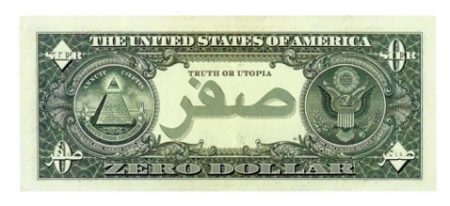
To make his point, Sy uses throughout his displayed pieces a one dollar bill in which he has replaced the listed monetary value of One by “Sifr” or “Zero”, thus alluding to the futility of the value we give money in our world, a value, however, that still and contradictorally controls and corrupts us. He uses on purpose a copy of the US dollar to underline the role America plays in promoting, legitimizing, establishing as reference and exploiting this value system that controls the world. And he displays on the bill, instead of the words “In God We Trust”, the words “Truth or Utopia” intending them as a wake up call to the reality of our belief system.

In fact one of the first pieces that welcomes the visitor at his show is “The Carrot and The Stick”, a mixed media photograph in which a donkey is lured with rewarding food by a hanging piece of dollar with the “zero” value on it. Sy’s allegory speaks of our own societal value system where money has become the ultimate rewarding endpoint, and this despite its illusionary and utopic character. As the title implies, it is a system that has succeeded in altering our own natural condition, our spontaneous likes and dislikes, our real inward motivations, and as a result has replaced our genuine humanity by an acquired reactive behavior to a set of alienating imposed rules.

No wonder then that Sy’s tree of life, as depicted in his “No Comment” photograph, despite its very few material roots, still grows big, dominant and overpowering, thanks to the increasing amounts of money amassed by the many hands. It is life equated to the number of dollar bills, despite their real null value. Composing his photograph, Sy used the same repeated and progressively enlarged image, most likely referring to our complacent, obedient and blind-following role, like “moutons de Panurge”, in this unnatural system, the power of which we actively help to amplify.

This illusionary power, sadly, has found its way into our intimate lives and has become rooted in our daily behavior. In “His and Hers” Sy stresses this point by representing side by side the sleeping pillows of a couple in the intimacy of their shared bed. The pillows on which each places their head is filled with “zero” dollars, pointing to the “important” things on which we now “sleep”. The pillows are also well separated, money coming in the way, divisive, altering our inner selves.

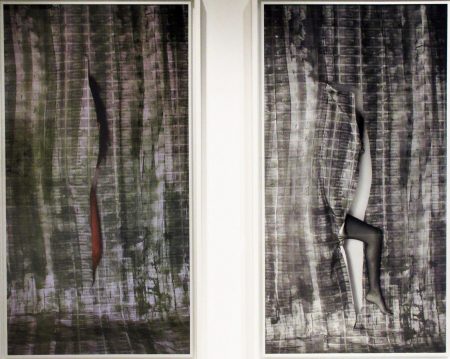
Money has also vitiated the understanding and the role of gender in our society. In “L’Origine du Nouveau Monde”, a tribute to Gustave Courbet who, in his painting of the same name, had represented and honored the birthpart of a woman, Sy substitutes a nest filled with his “zero” dollars. It is his reference to a “new” life and new order regimented by money, while also referring to the role this latter plays in the exploitation of women. In fact women become sex objects, subjugated by money, as depicted in his “Breaking the Green Barrier, 1 and 2“. In order to succeed, survive and become visible, women now need to willingly and submissively break the “green barrier” of money, i.e. enter the world of financial exploitation.
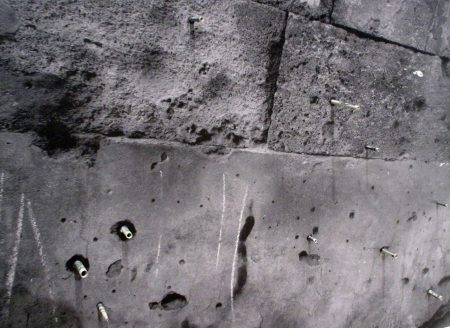

There is no question in Sy’s mind that violence, conflicts and wars are motivated by gain and profit, by the dollar which triggers them, justifies them, feeds them and maintains them. In “Big Business” he reiterates that behind every bullet is a load of money. His images of walls scarred by the Lebanese civil war have each of their bullet holes painstakingly physically filled with rolls of his “zero” dollars. These dollars, Sy points out sarcastically, do not, however, provide much protection to the warriors themselves. His “Bulletproof Vest K” is covered by the paper “zero” dollars, an illusion of a sturdy protective coat. At the end, it is clearly the vulnerable fighter who will pay with his life, the dollar protecting only the war manipulator, the ultimate winner.

When he comments on justice, essential for peace, Sy sways the weight balance of his “Lady Justice” towards the plate where his “zero” dollars lay. It is his clear statement that justice, thus influenced by money, ceases to be neutral and that, as a result, no real peace could be attained.
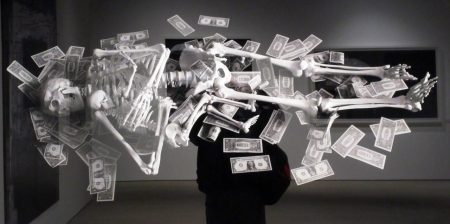
In his photograph “Migrants”, in which he addresses one of the major problems our world faces today, Sy shows the skeleton of a migrant holding the skeleton of his baby child, surrounded by “zero” dollars constituting both the shroud and the deathbed. He is thus directly linking money to the cause of the demise and to the injustice and distress that affect millions and millions of individuals throughout the world, destroying their countries, their families and their lives.
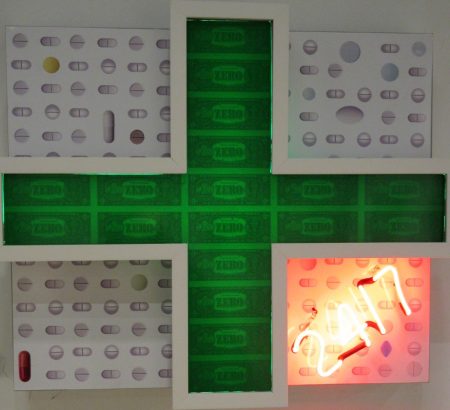
Throughout his exhibit Sy deals with many other nefarious influences of money on various aspects of our lives. He tackles, among other, love, personal relationships, politics, security… In his neon installation “Open 24/7” he confronts the all for profit drug industry which plays with our health and keeps us vulnerable, dependent and under control. His pharmacy sign is composed of his “zero” dollar bills and his neon sign loudly states, not to worry, that our addiction could be fed 24 hours a day, entertained by money.
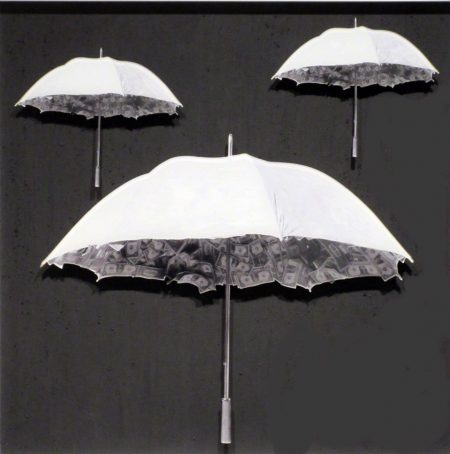
What a sad but real world that Sy paints through his work, a world at the brutal mercy of money. Sy does not leave us, unfortunately, with much hope. One of the last pieces one sees before exiting the exhibit is his mixed media photograph “Three Umbrellas”, a piece he did as a tribute to Magritte. It represents 3 floating umbrellas, the undersides of which are covered with his “zero” dollars. Gone is the surreal dreamy world that Magritte depicted. It is here, and realistically, replaced by the heavy material and corrupt world of the everyday dollar, overcasting our every moment and presenting itself as our (illusionary) protective shield.
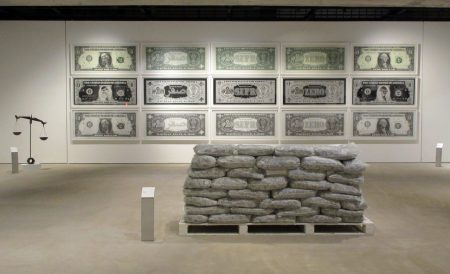
Indeed one leaves Sy’s show sad, angry, overwhelmed and feeling somewhat helpless faced with the immensity of the corrupt and the de facto reality of being controlled by money. Sy, however, wants to remind us that, that to which we give a lot of value and that we allow to control each aspect of our life, is in fact illusionary and utopic and that we need to step back, reflect, become aware, rebel, ask to regain our inner self, and not be afraid to fight in order to get it back.
–Saad Ghosn
Thank you Saad for the extensive story of Hady Sy. Money goes a long way to cover all bases. Hady Sy uses it to create works seen hung in the wealthiest and the poorest homes.
Thank you Saad for the extensive story of Hady Sy. Money goes a long way to cover all bases. Hady Sy uses it to create works seen hung in the wealthiest and the poorest homes.
Thanks for bringing this exhibit into our view; a thoughtful and exhaustive representation of the controlling aspect of our relationship to money–and its universality. The image of “Migrants” haunts me in particular. Your review well summarizes the intention, and enriched my understanding. Somehow understanding promotes more hope than despair—thank you for that.
Thanks for bringing this exhibit into our view; a thoughtful and exhaustive representation of the controlling aspect of our relationship to money–and its universality. The image of “Migrants” haunts me in particular. Your review well summarizes the intention, and enriched my understanding. Somehow understanding promotes more hope than despair—thank you for that.